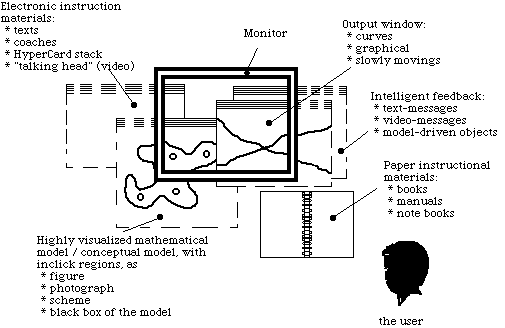Parallelism
A lot of users don't like computers, hypermedia or web-media because they lost there way in hyperspace and the information they need to solve a problem. A user want to have much better overviews about what they are doing in computer- or web-based environments. The screen of a standard PC has a terrible small surface to do something, to work on tasks, or to learn in high tech e-learning environments. (Min, 1994)
The philosophy behind the concept and the idea of paralllelism is: using bigger screens or more screens; viewports or web-frames; or different layers with information as pieces of papers on a desk: as windows as recommend in the desk-top-philosophy.

The concept of parallelism. This learning environment (with simulations) contains a lot of windows: windows with texts, windows with pictures, windows with micro-world problems, windows with intelligent feedback (text-messages or video-messages), even paper-based manuals as extra 'windows'.
In this scheme you see - schematic - a simulation based open learning environment with a lot of parallel windows even parallel paper materials, all the important information for solving the problem is in view and the user have them all under control.
We suppose that a user can only work or learn as his environment has been designed in such a way that all relevant information, to take decisions, is visible or can be immediately retrieved. On studying various kinds and large numbers of examples, it turned out time and again that parallel presented instruction yielded better results than simple provided in an hypermedium or simple structured web-site.
It is clear that users of educative software like to have all information well-ordered and at hand. The learner want to be able to see the connection or coherence of things. The fact that large screens are so popular partly proves the ideas found on parallelism. Users want to be able to put relevant information somewhere, preferably on a large screen, so that they can consult it without having to move other relevant information from the screen.
References
Min, F.B.M., (1994)
Parallelism in open learning and working environments. Britsh Journal of Educational Technology, Vol. 25, no. 2, p. 108-112. ISSN 0007-1013.
Ainsworth, S. (1999).
The functions of multiple representations. Computers and Education, 33, 131-152.
Benshoof, L.A., en S. Hooper (1993)
The effectes of single- and multiple-Window Presentation on Archievements During Computer-Based Instruction'. J. of Comp. Based Inst. vol. 20, no. 4, p. 113-117.
Bly, S. A., & Rosenberg, J. K. (1986)
A comparison of tiled and overlapping windows. Proceedings of the CHI 86, human factors in computing systems conference, 101-106. New York: Assiociation for computing machinery.
Enschede, august 2001
